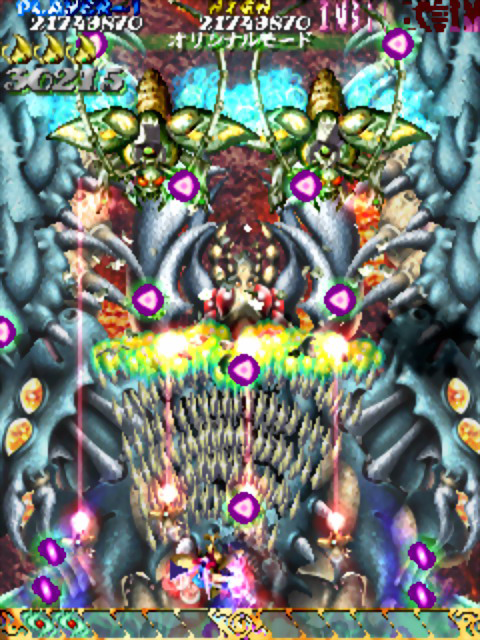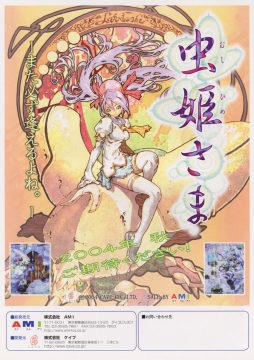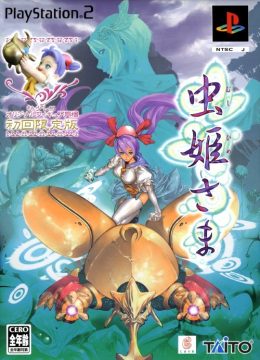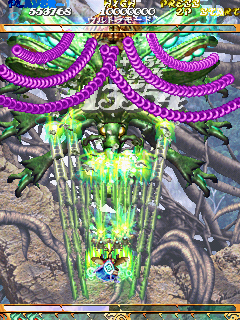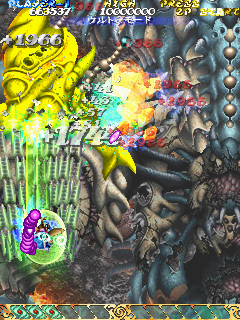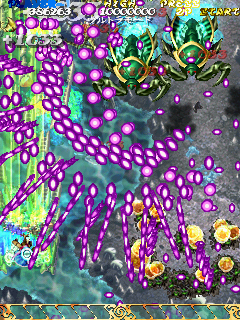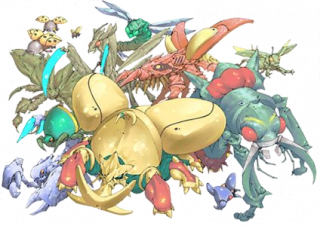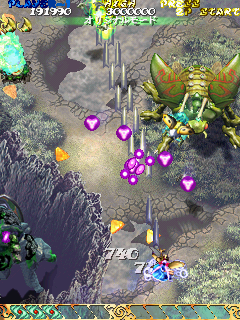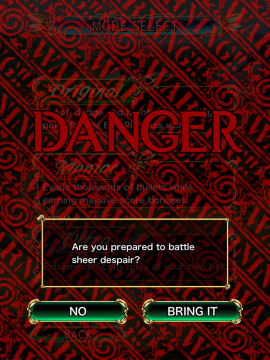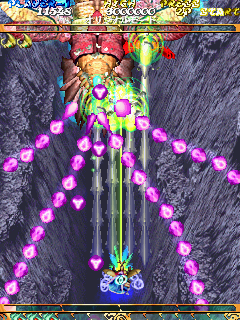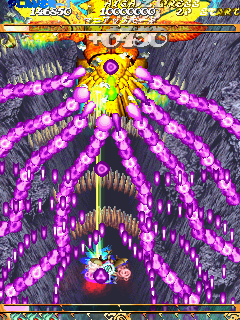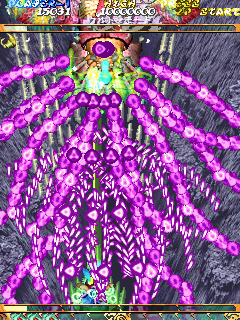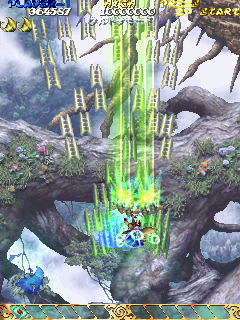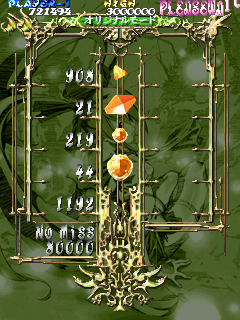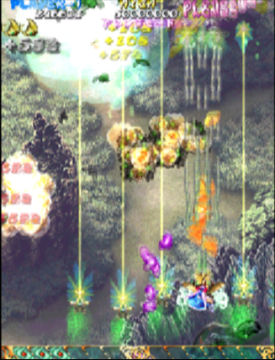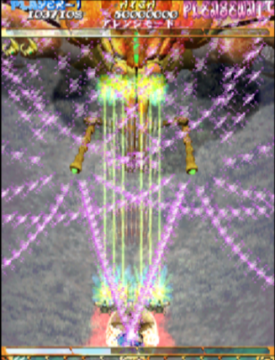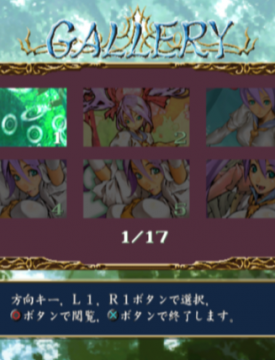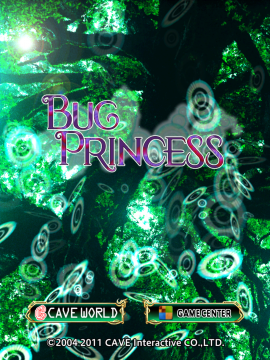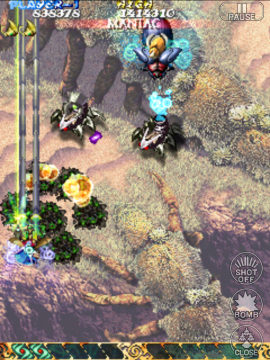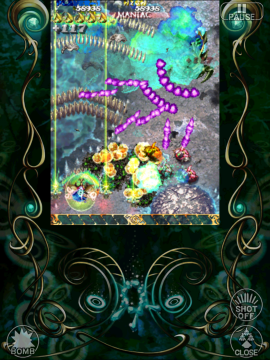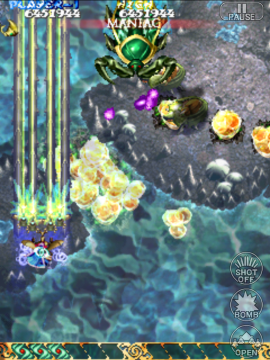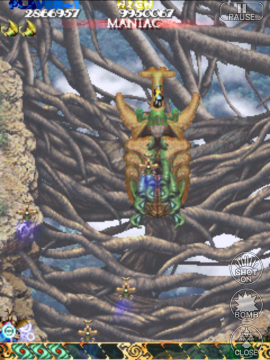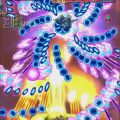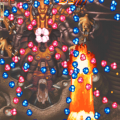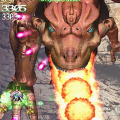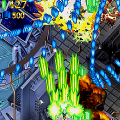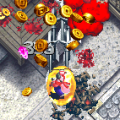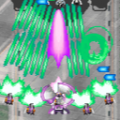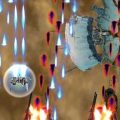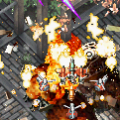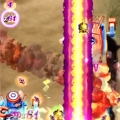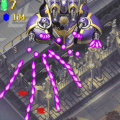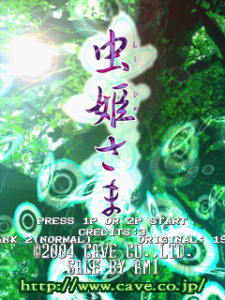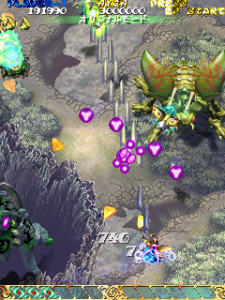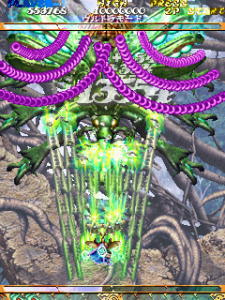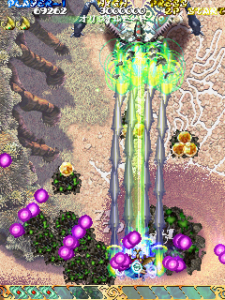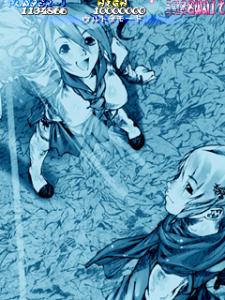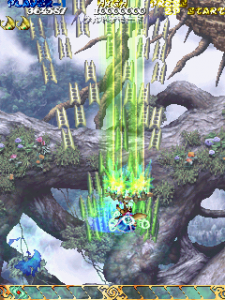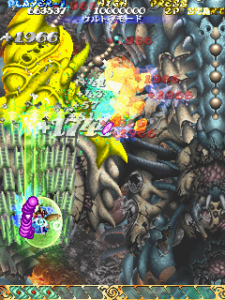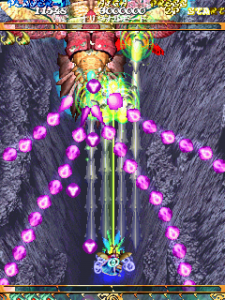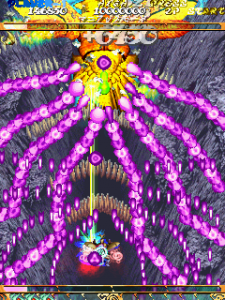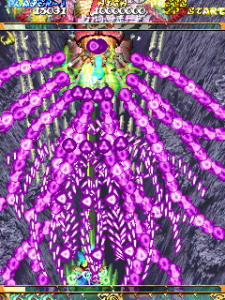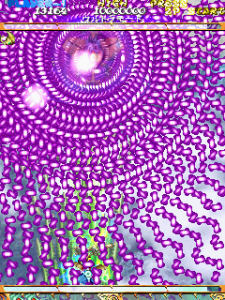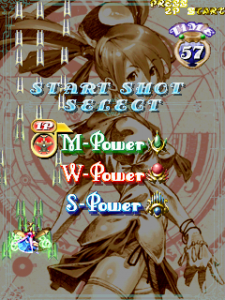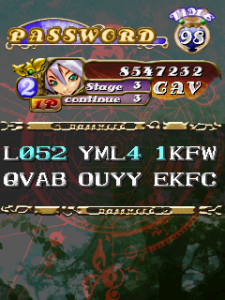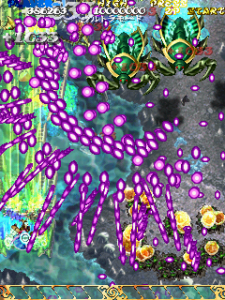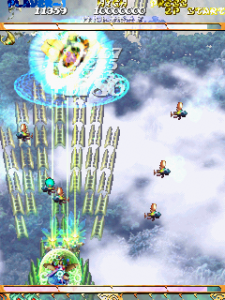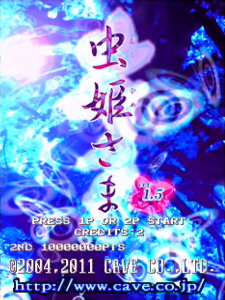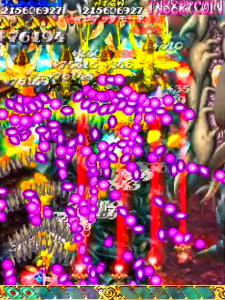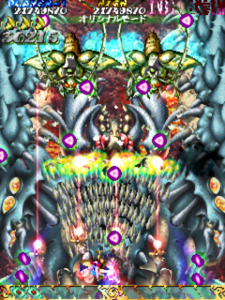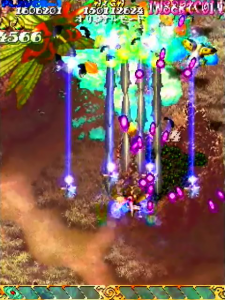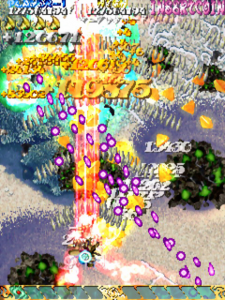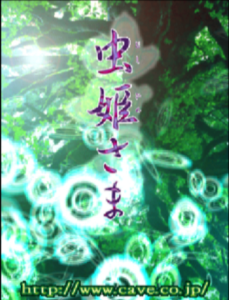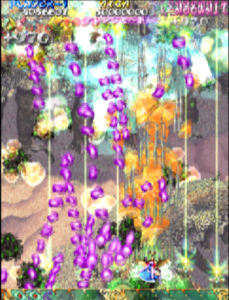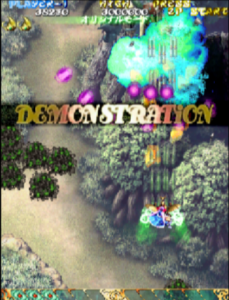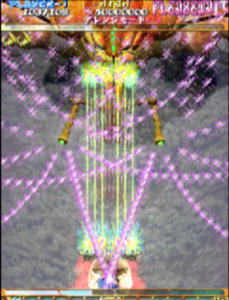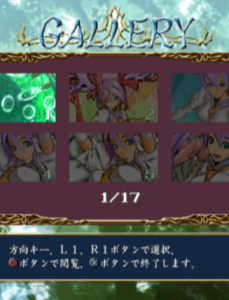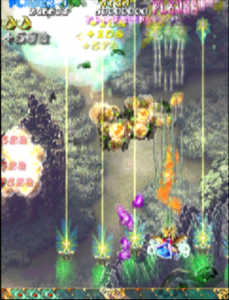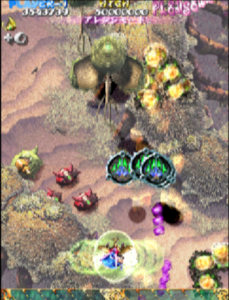When creating a game, the most important thing to be is flexible. One day your game could be an ultra macho military game featuring tanks, helicopters, and transforming mechas; and the next day that hardcore mecha fighting jet becomes a cute little girl riding a beetle. The grey and dirty world of military might replaced by color and wonder of nature. This very scenario actually occurred during the development of the first Mushihime-sama game. Both the main character and world of Mushihime-sama were directly influenced by the Hayao Miyazaki film, Nausicaa of The Valley of The Wind. From the early stages of development, the game was set to star a girl character riding on some sort of insect, its world being one of nature with various insects for the enemies.
In Japan, the series would gain popularity thanks to its unique setting and engaging gameplay, resulting in sold-out superplay DVD releases and a popular toy maker, MAX Factory create a 1/4 scale statue of the main character, Reco. The Mushihime-sama series itself consists of four games: The original arcade shmup, Mushihime-sama; its sequel Mushihime-sama Futari; a spinoff puzzle game, Puzzle! Mushihime-tama; and a spinoff smartphone game, Mushihimesama Bug Panic!?. In addition to the four main entries, Mushihime-sama and its sequel Mushihime-sama Futari would receive a number of updates and revisions. These two games were also ported to the PlayStation 2 and Xbox 360, and even iOS devices (under the translated Bug Princess titling), years after their initial release. But over here in the West, the series initially gained intrest thanks to a rather infamous YouTube video. Perhaps you might have seen it? That video introduced many people, including the author, to the wonderfully challenging world of Mushihime-sama and the bullet hell that are Cave shmups. This post aims to serve as a general primer for the Mushihime-sama series and its major releases. Providing knowledge and insight on the history, story, characters, gameplay and the scoring systems for each major release and revision in this wonderful series of games.
Developed by Cave co. ltd, Mushihime-sama was released into Japanese arcades on on October 12, 2004. The release of Mushihime-sama also marked the debut of Cave’s latest hardware: the CAVE CV1000. Known more commonly as the SH-3, this hardware would continue to be used by Cave until their final arcade shoot-em-up release, Dodonpachi Saidaioujou, in early 2012. Normally, when a new piece of hardware is launched, any games that launch with the hardware attempt to demonstrate what the hardware is capable of. With that in mind, Mushihime-sama demonstrates that the SH-3 hardware is can handle gorgeously detailed sprite art, explosions, 3D models, more than twenty enemies of various sizes on screen at once, huge and intricately detailed backgrounds, and even pump out great music all at once without any drops in framerate or input lag. Oh, and the possible 2,000+ bullets on screen at any given time, again, without any hardware-induced slowdown. (For reference, Dodonpachi could only have up to 245 bullets on screen.)
Up until this point, the shmups Cave developed were of the “danmaku” or “bullet curtain” genre, and as such the difficulty in their games being very high. Their games were notoriously unforgiving, often requiring hundreds of hours of practice to master. While their target audience may have reveled in the face of this challenge, most gamers did not, and took their money elsewhere. This caused game designer Tsuneki Ikeda to feel that there was a need in the market for shmup with simpler patterns and fewer bullets. With that in mind, Cave developed Mushihime-sama as a means to go back to their “Toaplan roots”,as Cave was formed by former employees of Toplan.
Before the release of Mushihime-sama, the term “shmup” usually brought forth images of space ships, fighter jets, big lasers, massive explosions, alien bosses, Moai heads. There may have been some outliers, (such as the Parodious series, and the “cute-em-up” genre,) but as a whole, the market was dominated by militaristic or sci-fi worlds. Originally, Mushihime-sama was to continue that trend, being an ultra-realistic “tanks and helicopters only” world. This was later changed when Cave heard that a new Raiden game was coming out, causing Cave to go forth with a more fantasy themed setting. Thus Cave decided to go with as far away from the dulled and mute colors of militaristic and industrial pallets, to the beauty and diversity of nature. And bugs.
The world of Mushihime-sama is dominated by gigantic arthropods. What little is left of humanity refers to these creatures as “Koju”. The Koju, (“Ko” for “carapace” and “Ju” for “beast”), exist in many forms in order to survive in this untamed world filled with lush forests, vast deserts, volcanic mountains, and uncharted underwater caves. The humans that remain have managed to set up small settlements where they struggle to survive. The reason the Koju are able to thrive is due to their “Levitation Energy,” which allows them the power of flight, in addition to the ability to channel this energy into bullets to use as weapons. This mysterious energy that the Koju emit is actually poisonous to humans, who have dubbed it the Miasma. Having no means to defend themselves against the beasts known as Koju, the humans miraculously managed to contact the God of the Koju and allow them safe place to live: Hoshifuri Village, a villiage inside the Shinju Forest. As payment for this, once every 200 years the humans are to provide the God of Koju with a sacrifice to earn their place in the forest: a young person who would turn 15 years old. Our heroine, princess Reco happens to be chosen as the next sacrifice; however, the village refused to give her up to the forrest. Their selfish actions angered the God of Koju, causing Hoshifuri Village to become plagued with the Miasma, poisoning everyone except for Reco. In an effort to save her village, Reco, and her companion Kiniro, goes into the forest to find the God of Koju and have him stop this attack.
Characters
Reco
The 15-year-old heroine of Mushihime-sama. Reco is the daughter of the royal family in Hoshifuri Village, and is also set to be the next sacrifice due to the stone bracelet she received as a young girl from a young boy when she got lost playing in Shinju Forest. Reco has a bright and curious nature, but tends to act without thinking; causing a fair bit of trouble for herself and those around her. When the village become plagued by the Miasma, Reco then sets off in search of the god of Shinju Forest to save her village on the back of her friend: a Koju named Kiniro.
Kiniro
A golden Rhinoceros Beetle Koju. Reco’s friend and partner for this journey. He is able to communicate with Reco due to the stone bracelet she wears. While normally well-behaved and quiet, he becomes ruthless if his life is in danger. Kiniro is also particularly hostile against Stag Beetle Kojus, often being the one to start a fight with them.
Koju
A general term for the giant arthropods that inhabit the land. While mostly living in the forested areas, some Koju live in desert areas. The Koju sprout vegetation from their carapaces when they die. The Koju possess an organic power known as “levitation energy”, which allows them to not only fly, but can be shot like a weapon as well. This energy is poisonous to humans, and the humans have dubbed this energy as the “Miasma.”
Aki
A mysterious boy that seems to live in Shinju Forest. He was the person who gave Reco her stone bracelet when she was lost in Shinju Forest as a young girl. He seems to act as a guardian for the humans, and keeps the forest Koju from attacking Hoshifuri Village. He likes taking walks. Could he actually be…?
As stated earlier, Mushihime-sama is a bullet hell styled shmup, a genre that Cave solidified with their DoDonPachiseries. What this means, is that there will be a lot of bullets on screen, with very few safe spots. The game will take Reco and Kiniro across 5 stages, each with a mini-boss and stage boss, and under certain conditions, a True Last Boss (TLB) after the stage 5 boss is defeated. Mushihime-sama was also unique in that it only has one loop of play, rather than the harder second loop, known as the “Omote loop” or the even harder version called the “Ura loop” found in other Cave games like DoDonPachi and Ketsui. Mushihime-sama uses an 8 way joystick and 3 buttons to play. By pressing and releasing the A button, Reco will fire use her normal shot. Rapidly pressing and releasing the button will cause her to fire faster. Holding down the A button will cause Reco’s hitbox to appear, her options to fire their lasers, and Reco’s movement to slow down. Pressing the B button will throw a Burst Seed, which acts like a screen-clearing bomb. The C button acts as a rapid fire A Button, holding the C button down is the equivalent of rapidly pressing the A button as fast as the game will allow.The player will only lose a life if the Reco’s hitbox, the center of the glowing center on Reco, is breached by the hitbox of a bullet. This is important, as the artwork for bullets can be larger than their actual programmed hitboxes.
When starting a new game, players are to first choose which game mode they want to play: Original, Maniac, or, after certain conditions were met, a third, even harder unlockable Ultra mode. These are the equivalent of the standard normal, hard, and “harder than hard plus one more hard” modes. Each mode also has a unique scoring mechanic, which will be detailed later. While Original mode is the easiest mode of the three, it is by no means trivial to clear on a single credit. At times there will literally be hundreds of enemy bullets on screen at once, but with enough practice and memorization, things become more manageable. Earlier, it was stated, that in Original mode, there will be times where hundreds of enemy bullets may be on screen at once; in Maniac mode, there will usually always be hundreds of enemy bullets on screen, and at times, more than one thousand. (It’s called Maniac mode for a reason now). Which leads us to the hardest difficulty setting: Ultra mode. When selecting Ultra mode the menu screen dims, followed by several diagonal “WARNING”s fill the screen. As the “WARNING”s begin to scroll, two big red pieces of kanji appear in the center of the screen, along with a message for the player: “Are you ready for instant death?”
It is at this point most players would select “No” causing the menu to go away, and the selection arrow to move up twice back to Original. However…should a player disregard the warning and respond “Bring it.”, the game then removes the limiters and does its best to punish the player for their hubris via an unrelenting assault on both Reco and the player’s eyes from the seemingly infinite number of pink and purple bullets that spew forth from enemies in beautiful patterns that will likely lead to the Reco, and the player’s demise.
Reco’s search for the God of Koju will not be an easy one, (especially in Ultra mode). Luckily, due to her Koju companion Kiniro, she is able to fight back by using the “Levitation Energy” that all Koju possess. Kiniro can shoot three different shot types, known as “Powers” in game: M-Power, W-Power, and S-Power. M-Power (the green icon) is the best all-around shot type, protects the duos’ front without altering mobility. W-Power (the red icon) is a wide shot type that is great for clearing out large groups of enemies at the sacrifice of some mobility. And the S-Power (the blue icon), shoots a concentrated and powerful attack that is good for taking out single enemies and bosses; and because of its focused attack, Reco and Kiniro are able to move faster. Interestingly, it is Reco which provides the bombs, known as Burst Seeds, in Mushihime-sama. When thrown, it will clear the screen of bullets, and auto-targets and damages whatever enemies it lands on, which can lead to some irritating situations due to auto targeting. However, using a Burst seed envelops Reco in a shield, making her invincible for a few seconds.
Rounding out the duo’s arsenal are 4 friendly Kabutan (Koju babies) that act like “options” from other shooters. There are two different option types and these are picked up during gameplay. The option types are: the trace type, where the options follow Reco’s movement, and the formation type, where the options remain alongside Reco. Should Reco get hit and lose a life, any options the player had will be scattered about the screen, but the player will not lose their shot power. During the game, certain enemies will drop either shot or option powerups that match Reco’s current weapon type. These power ups will float around on the screen until picked up or disappear due to the screen scrolling. Should a player not collect a power up, it will actually change into the next shot or option type after a few seconds, useful for areas when a weapon just isn’t cutting it. Careful, as getting hit will cause Kiniro to revert back to the shot-type selected at the start of the game.
Shot density differences
In most shoot-em-ups there are two methods of play, survival and scoring, with the latter usually requiring a mastery of survival to achieve respectable scores, and the highest scores coming from NMNB (No Miss (deaths) No Bomb) runs. This axiom remains true in Mushihime-sama, where either using bombs or losing a life will affect or reset the score multiplier, a killer in the later stages. Luckily the penalty for using a bomb is nowhere near as harsh as some of other Cave’s entries such as DoDonPachi. Instead of resetting the counter to zero, the multiplier just goes down a set amount. The main component of scoring comes from the gems that enemies drop; the types of gems that can drop are the small and large diamond gems (100 and 1000 points) dropped from airborne enemies, and the small and large hexagonal gems (825 and 2000 points) dropped from ground enemies. The ground gems will remain where they drop, and the airborne gems will slowly fall to the bottom of the screen. The number of gems collected on the current life on the current stage along with a bonus for not “missing” (dying) is added together as a score bonus at the end of each stage. After the final stage, the number of lives and bombs remaining are also factored in, resulting in the final score.
Mushihime-sama features two distinct scoring systems depending on the selected mode. Original mode features a relatively simple scoring system for a Cave game, relying on a few simple mechanics: not dying or using bombs, killing everything on screen and collecting the leftover gems, maximizing the gems generated from a few “farming” or “milking” spots, and defeating the larger, bullet-canceling enemies only when the screen is filled with bullets for the maximum amount of gems. The other scoring mode is found in the Maniac and Ultra modes and features a substantially different scoring system than the one in Original mode.
In Maniac/Ultra mode, there is a counter in the upper-left corner of the screen, known as the “parent” counter. The parent counter acts very similarly to the hit counter in DoDonPachi, increasing when Reco is shooting enemies on screen with her shot, and rapidly decreases whenever there Reco is not hitting an enemy with her shot. Each enemy has their own counter as well, that similarly to the parent counter decreases rapidly when not getting hit by a shot. Once Reco gains an option power-up a new counter is introduced: the “child” counter. Each option has its own child counter, meaning that if Reco has two options hitting an enemy, there will be two child counters in addition to the normal counter on that enemy. The child counter will only increase if that option’s laser is hitting an enemy using the A shot. Once the child counters are high enough players can add the value of each child counter into the parent counter by pressing the C shot. This technique is known as “counter banking.”
For example, if the player has 4 child counters with a value of 500 each, each tap of the C button will add 2,000 to the parent counter, causing it to skyrocket to outrageous amounts. Be forewarned, “counter banking” or “counter skyrocketing” causes the value of the child counter to rapidly decrease. In this way, there is a constant risk vs. reward system for scoring, as a player needs to keep enemies on screen to prevent the hit counter from decreasing, while also quickly dispatching enemies as they appear to have the largest amount of scoring gems appear. The key to achieving high scores in these modes is to always be increasing the score counter whenever possible, and maintaining its level. To achieve this, players must learn when and where to tap the shot or auto fire buttons anywhere from 2 to 7+ times a second to effectively maintain a high score counter throughout a stage to either be increasing or not decreasing the score counter. One final note on the scoring in Mushihime-sama and, Cave games in general, is that most of the player’s score will come from the final stage, or even the final boss.
The music in Mushihime-sama isn’t the best Cave has ever made, but it is still a solid entry and a great demonstration of what the SH3 hardware can do. Composed by Manabu Namiki and Masaharu Iwata, it’s done in an upbeat electro-syth style that does well at enhancing the mood and feel of each stage, bringing out the uniqueness and vast differences of each stage. Probably the most striking track in Mushihime-sama is the true last boss’s music,” Requiem of The Sky.” In a drastic change in tone, the true last boss’s track is a rather calm and mellow track, with a choir providing the melody. It almost sounds out of place compared to the rest of the music when taken out of context of the game; but it is still a solid entry that results in a nice change of pace from the rest of the tracks.
Overall, the arcade version of Mushihime-sama is a good game, and a better than average launch title. It’s a challenging game regardless if playing for survival or score, but the simple scoring systems and only one playable character makes me wonder if Cave could have done more. Especially when Mushihime-sama is compared to some of the other shmups out at that time. The bullet patterns are good, the soundtrack is good, the game just feels…good, but not great. With things like more characters, the addition of some unique scoring systems, and a more focused vision; Mushihime-samareally could have been great. Sadly, none of those additions would find their way into an update or revision Mushihime-sama. They would instead be added into its sequel: Mushihime-sama Futari.
Mushihime-sama (虫姫さま) / Mushihime-sama [First Limited Edition] (虫姫さま [初回限定版]) / Mushihime-sama [TAITO BEST] (虫姫さま [タイトーベスト]) – PlayStation 2 (July 21, 2005)
Following its success in the Japanese arcades, Taito published a Cave developed port of Mushihime-sama to the PlayStation 2 in Japan in 2005. During its first print run, a regular and limited edition were available, with the latter offering a mini statue of a young Reco and Kiniro. The PlayStation 2 port contains two playable modes: “Arcade” and “Arrange,” an arranged mode of the original arcade game. Additionally, the previously condition-locked Ultra mode comes unlocked by default for the arcade mode. Outside of those two gameplay modes, there really isn’t much else in this port except the gallery mode. The gallery mode consists of 102 pieces of mostly concept art, with a few promotional art pieces thrown in the mix for good measure. It’s a nice touch that they didn’t have to put in. Another nice addition is found in the button configuration screen, players can set their rapid fire and rapid auto fire button speeds from 20 preset speeds, in an effort to alleviate the rapid amounts of button presses required in the arcade Maniac and Ultra modes. But other than the paltry amount of adjustable options, that’s it. There isn’t any sort of training mode, nor can a player store replays of their runs for later viewing. There is a high score table, but it’s only viewable when “Exit” is selected in the main menu.
The number of options in the port is abysmal. You can change the screen or sound settings, or save, load or enable auto save. In this version, the developers decided to add this forced blurred graphical filter on top of everything, which can be really hard on the eyes after a bit. Sadly, there is no way to turn this filter off. The only changeable screen options consist of adjusting the picture or having it display in “yoko” or “tate.” (Yoko is a form of vertical letterboxing where the screen has been scaled down to fit a TV sitting normally, and tate which allows the picture cover the entire screen similar to the arcade version.) To accomplish this, the game renders the screen display at a 90 degree angle, which means that to properly enjoy playing in tate mode; the player will have to physically rotate their TV on its side. Additionally, the previous Cave ports for the PlayStation 2, Dodonpachi Daioujou and Espgaluda featured 240p modes, which showed scanlines for an authentic arcade experience. This is feature is not present in Mushihime-sama.
Moving past the number of available options, the real reason for the port is to play the arcade game at home! Unfortunately the PlayStation 2 port of Mushihimesama is a rather disappointing. The game itself is playable, but it’s also pretty broken being far from an “arcade-perfect” release with an abysmal 70-75% slowdown accuracy. For example, in the PlayStation 2 port, maniac stage 3 runs much faster than in the arcade version, making it incredibly harder to properly score the stage. And in maniac stage 5 of the port, crucial slowdown against the midboss just isn’t there. It is even worse in Ultra mode, where the game seems to either run too fast, or is plagued with so much slowdown that everything seems to be stuck in molasses. These issues, while possibly tolerable, make scoring runs incredibly more difficult due to the precise shot timing required for high scores. Possibly in a means to this, Outside of the speed issues, certain enemies bullet patterns have been changed (most notable on the stage 4 boss). The scoring, power-up and difficulty settings in the arcade version are still present here. But these issues do not render the game itself unplayable; it is only when compared to its source material this game becomes an inferior, rather than an equal or enhanced version of the original game.
The other playable mode, Arrange isn’t so much an “enhanced” version of Mushihime-sama, but more of a different version of the game. The arrange mode is just that, an arranged version of the standard Mushihimesama game, which seems to be based on the maniac mode of the original game. Because of the curation, there is no difficulty selection when starting a game, instead the player goes straight to the starting shot select screen. In Arrange mode, Reco can now have a maximum of 6 options, up from 4 in the original mode. She also starts with all 6 options in the formation mode at the start of the game, making the first two stages little more than an extended tutorial to get used to the weapon switching mechanic. In the Arrange mode, Reco no longer has to wait for a powerup to change into a certain shot type; instead she can cycle through the S, W, and M powers with the push of a button. Sadly, she doesn’t start the game with a max level shot, and instead will have to achieve it through traditional means, as losing all Reco’s lives results in a game over. There are no continues in Arrange mode. The Arrange mode does contain remixed tracks for all 5 stages and boss battles.
The new Arrange mode is based on the maniac mode, with some alterations to the core scoring mechanics. In the original Maniac mode, players needed to have an intricate knowledge of the shot timings and placement to cause the score counter to skyrocket. This, along with the entire “counter banking” system has been removed in the Arrange mode, and has been replaced by simply getting point-blank to large enemies (preferably at the top of the screen) and holding down the A (shot) button to cause the counter to rapidly increase. Another welcome change is that players have more time in between enemies before the counter starts to fall. Also In Arrange Mode, Reco will now throw a bomb if she gets hit. With 3 bombs and 3 lives, the player essentially starts with 9 lives, with the added benefit that Reco now has an auto-life saver making it easier to get the “No Miss” bonus after each stage. This change also means that the bomb powerups found at the end of a stage are now pseudo one-ups. Players will still lose most of their score counter just as if a normal bomb was used. Keeping with tradition, most of the player’s score will be achieved on the final stage, with each remaining life awarding a whopping 100,000,000 (one hundred million) points after clearing!
Ultimately the PlayStation 2 port of Mushihime-sama isn’t worth seeking out. It has horrendous speed issues, and not much content on the disc. Arrange mode is a nice change of pace from the arcade mode, but it isn’t a significant enough change to be sought out. However, the Arrange mode was significant enough to cause Cave to include an adjusted version in the HD release of Mushihime-sama on the Xbox 360. Some of the remixed music was eventually released with “The Secret Lover”, an Insanity DVD containing high scoring runs (superplays) by some of the world’s best players. Unfortunately, this DVD wasn’t included in either version of the game, giving yet another reason to pass this one by.
Mushihime-sama HD (虫姫さま HD) – Xbox 360 (May 24, 2012)
In early 2009, Cave started porting their SH3 games to the Xbox 360 console. And on May 24, 2012 Cave released what was to be their final Xbox 360 port: Mushihime-sama HD. Continuing its trend with Xbox 360 ports, Mushihime-sama HD came in both regular and limited edition versions. The limited edition came with alternate cover art, an arranged soundtrack cd and a DLC voucher. Mushihime-sama HD includes three types of gameplay modes: Xbox 360 mode, Arrange mode, and Novice mode. A fourth mode, Mushihimesama Cave Matsuri Ver. 1.5, is available as a free download for the first print regular or limited edition versions of the game. Mushihime-sama HD takes advantage of the power of the Xbox 360 and Xbox Live, providing Online Leaderboards for each gameplay mode. Players can save their own Score Attack replays to a local storage device, and even submit it, along with their score, to the Xbox Live leaderboards. There, other players can download their replays to learn new strategies and routes from top scorers! Mushihime-sama HD Also features an adequately detailed training mode for all modes, allowing the player to start at the beginning or boss of each stage, along with adjustable options for lives, bombs, shot strength, number of options, and even number of points in the counter.
Noticeably absent from Mushihime-sama HD is the option to play the game using the original graphics. Every mode uses the updated sprites found in the Xbox 360 mode. It isn’t a deal breaker, but some people were upset at the silent omission of the original graphics, something that was present in Cave’s earlier Xbox 360 ports. The Xbox 360 mode of the game is the standard arcade version with improved graphics and sound. The Novice version of the game is aimed at people relatively new or unskilled at shmups, and features noticeably less intense bullet patterns and generally fewer bullets overall. The Arrange mode is the same Arrange mode created for the PlayStation 2 port. The fourth mode Mushihime-sama Ver. 1.5 is probably the most interesting mode of them all, featuring the largest number of unique changes and tweaks.
Originally released during Cave Matsuri 2011, this version of the game was only available for purchase through Cave’s online store for eight hours on May 27, 2011 and May 28, 2011. Thus making this edition of the game quite rare to find, making its exclusivity as DLC all the more valuable. It is worth noting that although a previous version of Mushihime-sama Ver. 1.5 was debuted at Cave Matsuri 2006 (referred to as Mushihime-sama Blue Label), it is quite different, featuring more simplistic changes than the 2011 version. Mushihime-sama Blue Label was only playable during Cave Matsuri 2006, and has not been made playable elsewhere.
Mushihimesama 1.5 features a newly remixed soundtrack exclusive to this game, arranged by Ryu Umemoto, and some of the backgrounds have had their colors altered. This version also has remixed enemy placement and throws some new bullet patterns at the player for good measure. Players can also now suck in ground gems by releasing the A button, as they can in Mushihime-sama Futari. Mushihime-sama Ver. 1.5 retains the Original, Maniac, and Ultra modes found in the standard arcade release, but differs when it comes to the shot selection screen. Now, players can choose from a normal or “MAX” version of the three shot types. Selecting a normal shot type will cause the game to be played with its usual scoring systems; while selecting a MAX shot type will cause a number of changes. For starters, selecting a MAX shot type will cause Reco to start with all four options (whose laser color now changes depending on the shot type) and maximum power for her selected shot, but she is also starts with only one Burst Seed. Not to worry though, as auto-bombing (with reduced damage and duration) is enabled in all MAX modes. Additionally, triggering auto-bomb will deplete a player’s bomb stock. Each MAX mode has a slightly altered scoring system depending on the mode originally selected before the shot type screen.
The scoring system in MAX Original acts very similarly to the Original mode found in Mushihime-sama Futari Ver. 1.5, as both systems are centered around a rank mode. In all MAX modes, there is now a counter in the top-left corner of the screen, which increases as the player collects gems. Players can increase this counter faster by shooting near enemies while shooting them, causing them to “shed” small gems. When collected, the base value that gem is then multiplied by the counter’s current value and added to the player’s score, while the base value of that gem is added to the counter itself. If the counter goes past 10,000, all bullets (even ones on screen) now have green outline in addition to a moderate speed increase. Should the counter go past 50,000, the bullets will now have a yellow outline, and yet another, more dramatic, increase in speed. The counter maxes out at 99,999. Despite the increase in bullet speed, a high counter gained by point-blanking enemies is the key to high scoring in this mode. Interestingly these rank increases do not occur when playing on the 2p side.
Maniac MAX and Ultra MAX both act very similar to their normal versions, but focus on an overall counter in the top left corner. Both the child counters for each option’s laser and the other shot counter return in these modes, but they too have been tweaked. This counter increases with each bullet that hits an enemy. The shot and child counters values are now added to the overall counter when an enemy is destroyed. The overall counter acts as a multiplier for the gems. Since the overall counter increases with each bullet that hits an enemy, it increases at a very rapid pace, and maxes out at 999,999. The overall counter is also reset at the beginning of each stage and whenever the player dies. Enemies no longer decrease in value as they stay on screen due to the new scoring mechanics.
The biggest complaint regarding Mushihime-sama HD is that it is region-locked to Japan, despite many of Cave’s Xbox 360 ports being region-free. It may also behoove you to track down an unused DLC code for the Mushihimesama Cave Matsuri Ver. 1.5 mode, featuring the same HD graphics, at a cost much lower than the out-of-print original PCB. Alternatively, this version was ported to Windows, making it a far more affordable alternative if you don’t missing missing the physical materials.
Bug Princess – iOS (December 15, 2011)
In what can only been seen as an effort to increase their audience, (and in turn, revenue) Cave ported Espgaluda II, one of their SH3 shmups, to the Apple App Store in 2010. This release would prove successful enough to have Mushihime-sama receive the porting treatment as well, starting with the game being retitled to its literal English translation: Bug Princess. In addition to the title translation, the in-game text and endings were also translated into English. Bug Princess is the fourth SH3-based game Cave ported to iOS, and the second Mushihime-sama series game to be released on the platform. (The first being Mushihime-sama Bug Panic.)
Bug Princess contains the standard modes found in the arcade (Original, Maniac, and Ultra). In addition to the standard three gameplay modes, the iOS version also has an additional difficulty setting that controls the number of bullets on screen. These four difficulty settings are: Novice, Normal, Hard, and Hell. With Novice being the easiest, having the fewest number of bullets on screen, and Hell difficulty being the hardest, having the same number of bullets as the arcade version. Unlike the arcade and PlayStation 2 versions of the game, the only mode unlocked at the start is Original mode. The other two modes are easy enough to unlock, as beating Original mode on the All Stages course unlocks Maniac mode, and beating Maniac unlocks on the All Stages course unlocks Ultra. Bug Princess also uses a credit system as a means of continuing from a Game Over. At first, the player will have no extra credits, but if they get a Game Over, they will permanently get an extra credit to use on their next attempt. Players will get another credit when they use all of their credits and receive the same number of Game Overs as their maximum credit count. A simple text and picture tutorial explaining the core concepts and systems of the game is can be accessed by pressing the “?” button on the main menu. This tutorial is updated as the difference game modes become unlocked.
Players can choose from two different “courses” of the game. The first course, All Stages, is the standard arcade mode with continues, and Score Attack, where players compete for the highest score on a single stage, with no continues. To unlock a stage for Score Attack, players must first clear the stage in the All Stages course for that gameplay mode. Both courses have their own local and global high score tables. These leaderboards are viewed through the Game Center button located on the title screen, where players can also view the various achievements in the game, their point value, and the requirements for achieving for each entry.
In what’s become a staple of every non-arcade shoot-em-up release, Bug Princess includes a training, or practice mode. Bug Princess’s practice mode isn’t the most detailed training mode Cave has made, being rather basic in its options. Players can choose which game mode, shot type, stage to practice, along with the number of lives, bombs, options and shot power to start with. Note, that for a stage/mode to show up as an option, players must have successfully cleared that stage in that mode. It would have been nice to be able to start a stage from just before the boss, or even be able to adjust the starting counters, but what is there is certainly better than not having a training mode at all.
In the options menu, players can change the screen size from one of three preset options, allowing more room to move their fingers without covering the gameplay screen. Various “soft buttons”, performing such functions as bombing, altering option formation, or having Reco stop shooting has been added to the screen due to the lack of physical buttons. Players can select one of four pre-defined soft button layouts from the control menu. There is also a second page of the button layout menu, allowing for auto-bomb and/or shot off button to be turned on or off, and if the options should change formation only when the player is holding the button down, double taps the button, or switches formation whenever the button pressed. It is not possible to adjust the rapid fire speeds like in the PlayStation 2 port. Located in the “other” section of the options lies a cryptic option known as “wait control.” Enabled by default, this option acts a limiter, forcing the game to slow down at certain points (also in the arcade versions). Turning this option off causes “the bullet hell to be experienced with no limits.”, or in more explicit terms: removes the slowdown in the game. You have been warned.
Rounding out the options menu is a History tab. The History tab contains an entry for each of the main Mushihime-sama games: Bug Princess (Mushihimesama), its sequel Bug Princess 2 (Mushihimesama Futari) , the first spinoff game Puzzle! Mushihime-tama, and Mushihime-sama Bug Panic, an original game developed for smartphones. Clicking on one of the games will display the backstory and characters associated with that game, along with some information further fleshing out the Mushihimesama world. Lastly, the history entry also includes some screenshots (usually depicting how crazy the game can get) and, if available, a link to purchase that game on the devices’ app store.
The transition from the joysticks and buttons of an arcade release to the touch screens in smartphones, presented Cave with new problems in how the player would move and shoot in the game. Cave solved the shooting issue by having the characters always be shooting by default (as they would be anyway), and move their character by simply sliding their finger across the screen. Doing so will cause the player’s ship to mirror the movement relative to its current position with a stunning 1:1 accuracy. These two systems were first introduced in Cave’s first iOS outing: Espgaluda II. The new movement system also removed the previous movement speeds and their modifications from the shot-types, ultimately granting an unprecedented level of control. The new movement system may be a bit disorienting if coming from an arcade version, but it is rather intuitive, and is easy to get accustomed to. Another difference from the arcade version is that an auto-bomb system is present and turned on by default. If enabled, Reco will use up her entire bomb stock if she gets hit.
Bug Princess stands out from Cave’s previous smartphone offerings. It lacks any sort of “Smartphone” mode or any other remixed gameplay modes. Further differing itself from previous releases, Bug Princess is what’s known as a “universal app”, meaning that while there is only one app on the store, it can be used on any iDevice, and will use the version designed for whatever device it is on. Previous Cave entries had the iPhone/iPod Touch and iPad apps as two separate applications.
Bug Princess is a very good port of Mushihime-sama. The controls have been changed for a more smartphone-optimized experience, and perform flawlessly, and the slowdown in Bug Princess is arcade perfect! Sadly, this version came out before Mushihime-sama HD on the Xbox 360, so it is using the original arcade sprites rather than upgraded HD visuals. Even then, is easiest (and cheapest!) version of Mushihime-sama to acquire and play, and a good one at that.
Links:
Concept artwork A Cave fansite containing various art for the game
Arcade Revision information A Note about the various arcade bugs and revisions
Mushihimesama basics A brief overview and scoring tips from smhups.system11.org’s forums
Maniac & Ultra mode scoring A more in-depth look at the Maniac & Ultra scoring systems
Mushihimesama FAQ A great in-depth FAQ by Slateman
Mushihime-sama OST Playlist on Youtube
Links:
Arrange Mode 1CC A great run of the arrange mode with knowlegable commentary from the player himself!
Arrange mode OST Playlist A YouTube playlist of the Arrange mode OST “The Secret Lover”
Links:
Mushihimesama Music and Design InterviewTranslated interview with creators of Mushihimesama
Translated Famitsu Interview Great interview with Cave about porting Mushi to HD
Mushihimesama Cave Matsuri Ver 1.5 OST Playlist A YouTube playlist of the Cave Matsuri Arrange album
Mushihimesama Cave Matsuri Ver 1.5 Ultra MAX Stage 5 A nice run showing how crazy MAX can get!
Links:
Bug Princess at Cave-World Official Bug Princess Website
